Mysterious Prehistoric Statues In Bada Valley, Indonesia Surrounded With Countless Legends
A. Sutherland - AncientPages.com - There are hundreds of prehistoric megaliths and several impressive ancient stone statues located in the Bada Valley, Central Sulawesi just south of the Lore Lindu National Park, Indonesia.
They vary in shape and size and according to sources, the number of megalithic rocks is 1,451. No doubt, the megaliths represent a prehistoric heritage, older than Borobudur Temple, but no one knows exactly their purpose and use of these rocks in ancient times.
Two Dutch ladies standing by a statue in Bada Valley in the 1930s. Image credit: Tropenmuseum - CC BY-SA 3.0
Located in a distant, isolated village that only a small number of Indonesians have heard about, mysterious statues of Bada Valley, Indonesia have no inscriptions to explain what or who they actually symbolize, who their builders were, or why they were built.
The tallest and best-known carved standing stone statue in the valley is a statue known as 'Palindo' which translates as 'The Entertainer' and measures over 4 meters.
The "Entertainer" has round eyes and a large nose that extends down and a deeply carved mouth makes him Watu Palindo looking cheerful and friendly. Besides Watu Palindo, there is another famous stone - Langka Bulawa ("Queen with a golden leg"), which depicts a woman's figure.
There are 13 other finely carved statues in the Bada Valley, with others in the nearby Besoa and Napu valleys inside the Lore Lidu National Park.
Hundreds of megaliths in this region of the country that goes back to the 14th century are called watu ("stone") in the local Badaic language and arca ("statue") in Indonesian.
Some people suggest that the stones were carved around 5,000 years ago, while others say the megaliths were made about 1,000 years ago. Meanwhile, other people say that the stones are related to megalithic culture in Laos, Cambodia, and other regions in Indonesia in the past 2,000 years.
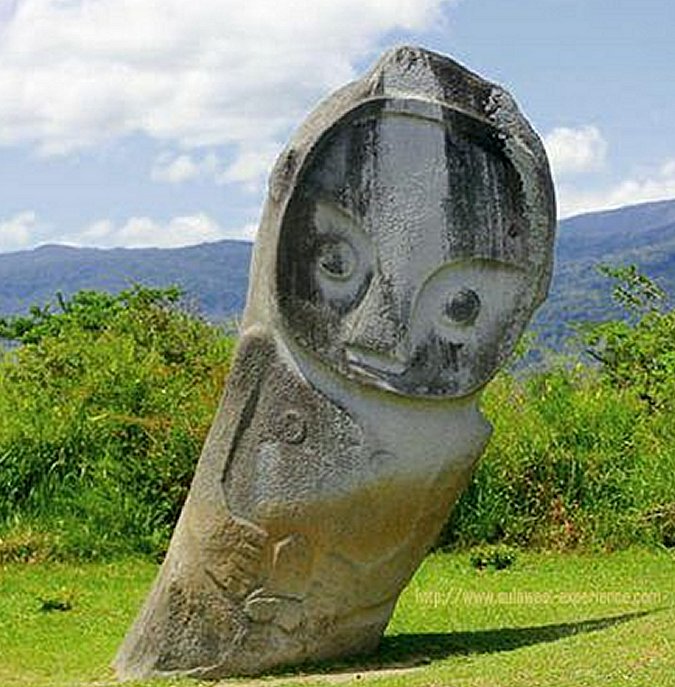
'Palindo' ('The Entertainer') measures over 4 meters. source
As we see, the dating of these impressive megaliths is uncertain, and for now, the bizarre statues are dated to be from 5000 to 1000 years old.
Archaeologists claim they haven’t found enough clues to explain their history yet, because at the time of their discovery, local people scraped the statues out of thick moss and dirt in order to clean them.
Other sources say, farmers grow rice around them and simply ignore them all, probably unaware of their historical value and mysteries behind them.
Many have long wondered who were these rock sculptors because it is commonly known that granite rocks are very hard, which makes working with them - very difficult.
Were The Megaliths Used To Worship Ancestors?
Local people Of Bada Valley and neighboring areas believe that the stone was used
to worship ancestors. They also have their own story about the origin of these very ancient megaliths.
Not only that, the residents also have stories about the origin of the formation
of these megaliths. According to local folklore, there was once a dangerous rapist who was finally condemned to be a piece of stone.
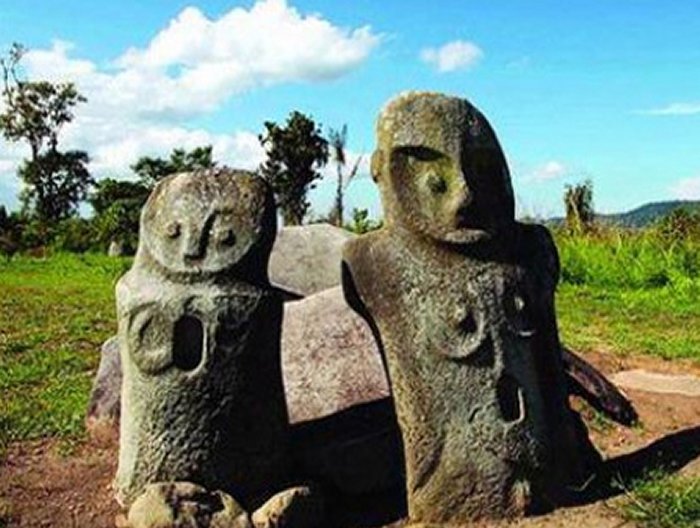
Bada Valley gigantic statues, Indonesia. source
Another story says about another large megalith named Tadulako. The community said that Tadulako was known as a village guard, but after stealing rice he was changed to stone.
Bada Valley's megaliths are also linked with human sacrifice or supernatural powers and some other ancient beliefs suggest they were intended to ward off evil spirits.
The elders in the village of Sepe believe that the statue of Palindo which means the entertainer in the local language is a representation of their predecessor population, the Tosaloge tribe. These people believe that the largest and the most celebrated statue in the area, which is that of Palindo ('The Entertainer') may represent Sepe's first mythological inhabitant, Tosaloge.
Yet another legend tells of the Raja of Luwu from the oldest kingdom in South Sulawesi, who once ordered 1800 statues to move from Sepe to Palopo. It was not an easy task for the workers because the distance between these two places is large.
Anyway, King Luwu wanted to prove his dominance over Bada, but his effort failed. One statue was ordered to originally face the south, but the Bada people turned it to face the west.
The Raja's followers tried to turn it back, but an accident happened and the statue fell onto its side, killing 200 people.
In the past, there was a tradition to give offerings to this statue before doing great work, such as opening new land for agriculture.
Written by – A. Sutherland - AncientPages.com Senior Staff Writer
Copyright © AncientPages.com All rights reserved. This material may not be published, broadcast, rewritten or redistributed in whole or part without the express written permission of AncientPages.com
Expand for referencesReferences:
Bellwood P. First Islanders: Prehistory and Human Migration in Island Southeast Asia
More From Ancient Pages
-
 Archaeological Site Along The Nile Reveals The Nubian Civilization That Flourished In Ancient Sudan
Civilizations | Apr 14, 2022
Archaeological Site Along The Nile Reveals The Nubian Civilization That Flourished In Ancient Sudan
Civilizations | Apr 14, 2022 -
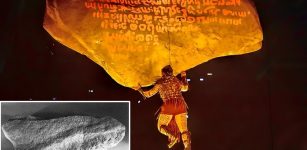 Undeciphered Singapore Stone’s Carvings – New Attempt To Crack The Puzzle
Artifacts | Jun 11, 2024
Undeciphered Singapore Stone’s Carvings – New Attempt To Crack The Puzzle
Artifacts | Jun 11, 2024 -
 Why Were Conch-Shell Trumpets So Important To The Ancient Chacoan Society?
Archaeology | May 7, 2024
Why Were Conch-Shell Trumpets So Important To The Ancient Chacoan Society?
Archaeology | May 7, 2024 -
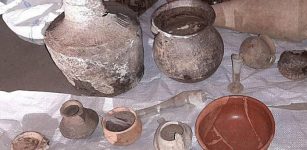 Europol Reports: ‘Millions’ In Stolen Treasures After Busting Crime Gang In Bulgaria – Recovered
Archaeology | Jul 4, 2020
Europol Reports: ‘Millions’ In Stolen Treasures After Busting Crime Gang In Bulgaria – Recovered
Archaeology | Jul 4, 2020 -
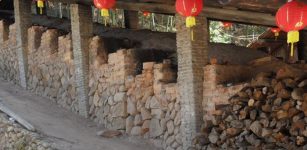 Ceramics Are Telling The Story Of 14th Century Chinese Trade
News | Jun 28, 2023
Ceramics Are Telling The Story Of 14th Century Chinese Trade
News | Jun 28, 2023 -
 Strange And Scary Encounter With Ancient Giants In North America
Ancient Mysteries | Sep 23, 2021
Strange And Scary Encounter With Ancient Giants In North America
Ancient Mysteries | Sep 23, 2021 -
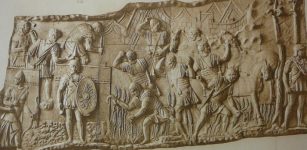 Secret Police In Ancient Rome – Frumentarii: Who Were They And What Was Their Role?
Featured Stories | Aug 12, 2019
Secret Police In Ancient Rome – Frumentarii: Who Were They And What Was Their Role?
Featured Stories | Aug 12, 2019 -
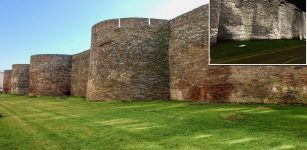 Walls Of Lugo: Finest Example Of Late Roman Fortifications – Stands The Test Of Time
Featured Stories | Sep 22, 2022
Walls Of Lugo: Finest Example Of Late Roman Fortifications – Stands The Test Of Time
Featured Stories | Sep 22, 2022 -
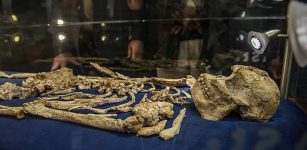 ‘Little Foot’ Is An Entirely New Species Of Early Human – Researchers Say
Archaeology | Jan 3, 2019
‘Little Foot’ Is An Entirely New Species Of Early Human – Researchers Say
Archaeology | Jan 3, 2019 -
 Mount Ararat Was Once Located By The Sea – Study Of Palm Leaves Reveals
Archaeology | Jul 18, 2020
Mount Ararat Was Once Located By The Sea – Study Of Palm Leaves Reveals
Archaeology | Jul 18, 2020 -
 Ancient Egyptian Blue Used To Create New Nanomaterial 100,000 Times Thinner Than A Human Hair
Ancient Technology | Mar 24, 2020
Ancient Egyptian Blue Used To Create New Nanomaterial 100,000 Times Thinner Than A Human Hair
Ancient Technology | Mar 24, 2020 -
 Graves Of Celtic Princes Reveal How Powerful Women Were In Pre-Roman Germany
Archaeology | Jun 4, 2024
Graves Of Celtic Princes Reveal How Powerful Women Were In Pre-Roman Germany
Archaeology | Jun 4, 2024 -
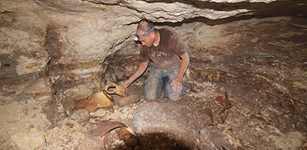 A 2000-Year-Old Jewish Settlement Near Bet Shemesh – Unearthed
Archaeology | Mar 30, 2017
A 2000-Year-Old Jewish Settlement Near Bet Shemesh – Unearthed
Archaeology | Mar 30, 2017 -
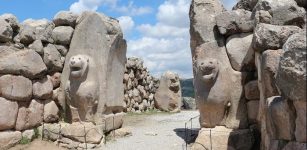 Yazılıkaya: One Of The Most Striking Religious Shrines Of The Hittite Empire
Featured Stories | Jul 4, 2023
Yazılıkaya: One Of The Most Striking Religious Shrines Of The Hittite Empire
Featured Stories | Jul 4, 2023 -
 Long-Lost Mesopotamian Queen Hama Discovered By Student Just By Reading Books
Archaeology | Feb 14, 2019
Long-Lost Mesopotamian Queen Hama Discovered By Student Just By Reading Books
Archaeology | Feb 14, 2019 -
 On This Day In History: Isaac Asimov Creator Of Science Fiction Was Born – On Jan 2, 1920
News | Jan 2, 2017
On This Day In History: Isaac Asimov Creator Of Science Fiction Was Born – On Jan 2, 1920
News | Jan 2, 2017 -
 Mystery Of The Strange Rock In New England That People Fear To Approach
Featured Stories | Apr 17, 2024
Mystery Of The Strange Rock In New England That People Fear To Approach
Featured Stories | Apr 17, 2024 -
 Fin Folk – Mythical Amphibious Sea People On Orkney And Shetland
Featured Stories | Feb 22, 2016
Fin Folk – Mythical Amphibious Sea People On Orkney And Shetland
Featured Stories | Feb 22, 2016 -
 On This Day In History: 150 Highly-Trained Swiss Guards Entered Vatican For The First Time – On Jan 22, 1506
News | Jan 22, 2017
On This Day In History: 150 Highly-Trained Swiss Guards Entered Vatican For The First Time – On Jan 22, 1506
News | Jan 22, 2017 -
 ‘Saimaluu-Tash’ Time Capsule: Largest Millennia-Old Collection Of Petroglyphs In Central Asia
Civilizations | Nov 20, 2018
‘Saimaluu-Tash’ Time Capsule: Largest Millennia-Old Collection Of Petroglyphs In Central Asia
Civilizations | Nov 20, 2018

